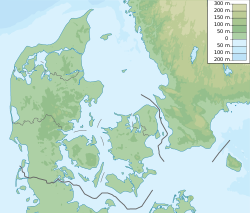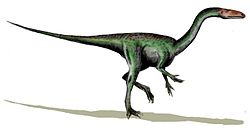Top Qs
Timeline
Chat
Perspective
Hasle Formation
Geologic formation on the island on Bornholm, Denmark From Wikipedia, the free encyclopedia
Remove ads
The Hasle Formation is a geologic formation on the island on Bornholm, Denmark. It is of early to late Pliensbachian age. Vertebrate fossils have been uncovered from this formation.[2][3] The type section of the formation is found at the south of the costal Hasle Town, and it is composed by rusty yellow to brownish siltstones and very fine-grained sandstones. The southernmost arch, Hvjdoddebuen, is not as fossil-bearing as the type unit in Hasle.[4] The formation can be separated in two different petrographic types: type 1 sandstones are friable with layers and lenses of concretionary siderite and type 2 well-cemented sandstones.[5] Both types where deposited in a relatively high-energy marine environment with a diagenetic pattern that demonstrates a close relation to various phases of subsidence and uplift in the tectonically unstable Fennoscandian Border Zone.[5] Most of its deposition happened on a storm-dominated shoreface, with the exposed parts deposited in an open marine shelf within 1–2 km distance from the fault-controlled coastlines.[6] However, recent works have recovered terrestrial fauna from it, including a footprint, suggesting easterly winds and low tide could have exposed the inner parts of the upper shoreface, and create long-lasting Floodplain-type environments.[7] Field works since 1984 have shown a mostly hummocky cross-stratified deposition, with great complexity of the sediments that suggests very complicated and variable flow conditions, with Megaripples derived from storm events.[8] Storms were frequent and the coastline faced a wide epeiric sea with a fetch towards the west of possibly 1000 kilometers.[8] The Jamesoni–Ibex Chronozone in the Central European Basin represents a clear sea Transgression, due to the appearance of ammonites from Thuringia and southern Lower Saxony, showing a full marine ingression towards the west.[9] This rise in the sea level is also measured in the north, as is proven by the presence of Uptonia jamesoni in Kurremölla (Röddinge Formation, Skåne) and Beaniceras centaurus plus Phricodoceras taylori on the Hasle Formation.[9] The whole Hasle Sandstones are a result of this rise in the sea level, where the marine sediments cover the deltaic layers of the Rønne Formation.[9] The rise in the sea level is observed on palynology, as on the Hasle Formation Nannoceratopsis senex (Dinoflajellate) and Mendicodinium reticulaturn (Algae Acritarch) appear, indicating a transition from paralic and restricted marine to fully marine.[10]
Remove ads
Fossil content
Summarize
Perspective
Annelida
Brachiopoda
Bivalvia
Scaphopoda
Gastropoda
Belemnites
Ammonites
Crustacea
Chondrichthyes
Unidentified fin spines are known from this formation.[2]
Actinopteri
Sauropterygia
Thalattosuchia
Pterosauria
Theropods
Sauropodomorpha
Synapsida
Remove ads
See also
- Blue Lias, England
- Charmouth Mudstone Formation, England
- Sorthat Formation, Denmark
- Zagaje Formation, Poland
- Drzewica Formation, Poland
- Ciechocinek Formation, Poland
- Borucice Formation, Poland
- Rotzo Formation, Italy
- Saltrio Formation, Italy
- Moltrasio Formation, Italy
- Marne di Monte Serrone, Italy
- Calcare di Sogno, Italy
- Podpeč Limestone, Slovenia
- Coimbra Formation, Portugal
- El Pedregal Formation, Spain
- Fernie Formation, Canada
- Whiteaves Formation, British Columbia
- Navajo Sandstone, Utah
- Aganane Formation, Morocco
- Tafraout Group, Morocco
- Azilal Formation, Morocco
- Budoš Limestone, Montenegro
- Kota Formation, India
- Cañadón Asfalto Formation, Argentina
- Los Molles Formation, Argentina
- Kandreho Formation, Madagascar
- Elliot Formation, South Africa
- Clarens Formation, South Africa
- Evergreen Formation, Australia
- Cattamarra Coal Measures, Australia
- Hanson Formation, Antarctica
- Mawson Formation, Antarctica
Remove ads
References
Wikiwand - on
Seamless Wikipedia browsing. On steroids.
Remove ads







































